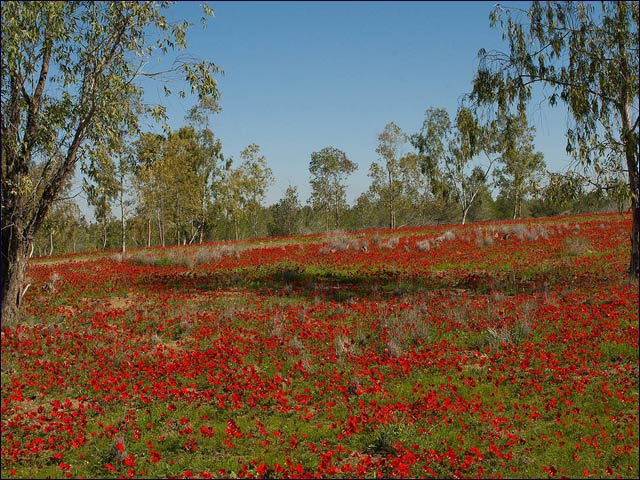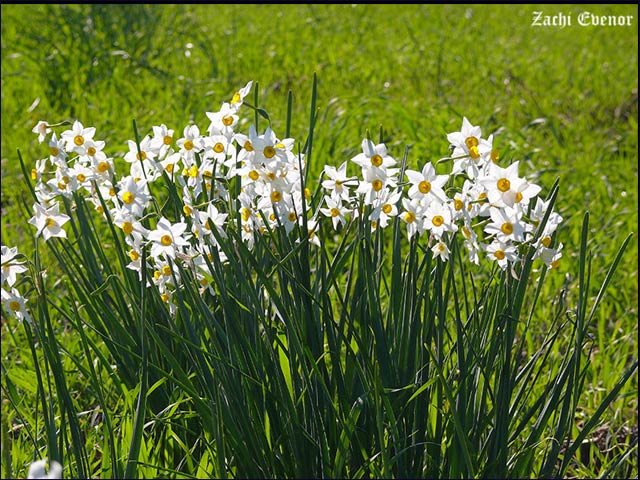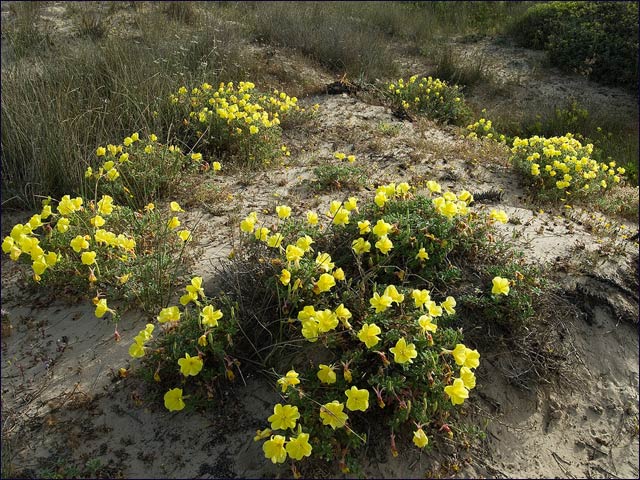By Avigayil Kadesh
The Gilboa Iris, a rare variety of this treasured purple flower, is the symbol of the
Society for the Protection of Nature in Israel because it was one of the many wildflowers brought back from the brink of extinction through a massive public-education campaign in the 1960s.
So by all means, go to Mount Gilboa in the Beit Shean Valley during the peak spring months and enjoy the sight, but don’t pick the irises!
If you have an uncontrollable urge to pluck some spring flowers (and who could blame you?) head to Kedma, a south-central village about an hour’s drive from Tel Aviv and Jerusalem. Here, during the intermediate days of Passover, you can buy a large vase and a pair of shears for NIS 40 so you can collect a bouquet to take home from the more than 100 different species of nuriyot (buttercups).
Flowers of the Negev
If you happen to be in Israel during the month of February, the annual
Scarlet South Festival in the northern Negev offers an opportunity to take free guided walks on the weekends through the red carpets of anemones in the Reim Recreation Area and the Ruhama Forest, courtesy of Keren Kayemeth LeIsrael-Jewish National Fund (KKL-JNF). 
Ruhama Forest anemone. Photo by Yehoshua Halevi Other areas in the Negev to see the wildflowers include Kibbutz Be’eri, and Sycamore Ranch (Havat Shikmim) -- home of the late former Prime Minister Ariel Sharon – which is not far from Ruhama Forest.
Though some species of Israeli wildflowers bloom nearly year-round, depending on the particular year and the amount of rainfall in that area of the country, February, March and April are the best times to enjoy the riotous colors. There are many favorite flowers including the anemone (kalanit), cyclamen (rakefet), narcissus (narkis) and lupine (tourmus).
And don’t forget the fruit trees, especially the almond, which burst into beautiful blossoms in the springtime, says Israeli photographer
Yehoshua Halevi, who is producing an ebook about photographing Israel through the seasons.
Springtime in Sataf and Glilot
Sataf nature preserve, to the east of Har Eitan on the western fringes of Jerusalem, is always a hikers’ paradise. But in the late winter – early spring, it is blanketed with blossoming almond trees and cyclamen in shades from white to dark pink.
You don’t have be a narcissist to enjoy the Valley of Narcissus Flowers (Emek HaNarkisim) in a field north of Tel Aviv near the Glilot Junction. Daisies also bloom at Glilot.

Valley of the Narcissus Flowers. Photo by Zachi Evenor Lupine Hill, Cyclamen Hill
On spring Fridays, Givat Hatourmusim (Lupine Hill), in the Elah Valley just south of Beit Shemesh, is mobbed with visitors admiring the thousands of purple lupines and other wildflowers.
Halevi leads photography workshops here, and it’s one of his favorite spots.
“It’s a 10-minute hike to the top, where there is the best collection of diverse wildflowers I’ve seen anywhere,” he says.

Lupine. Photo by Yehoshua Halevi And Halevi advises that it’s worth a trip to the other side of the road to see (and smell) the thousands of blossoms, ranging in color from white to pale pink, in the commercial almond orchard at Kibbutz HaLamed Heh.
If you’re looking for lupine, besides Givat Hatourmusim in the Elah Valley, Halevi suggests the area around Kibbutz Gonen, which is situated east of the Sea of Galilee just below the Golan Heights on Road 918.
“The eastern side of the road is full of lupines as far as the eye can see, as well as many other flowers,” he says. “You have to be a little adventurous, because there are no well-defined trails. I always find I make some of my best discoveries when I bushwhack my way through forests.”
Up north in the Megiddo area in the Jezreel Valley, the prime area for cyclamen is located in the pine tree grove of Ramot Menashe Park near the Elyakim Interchange.
Cyclamen Hill features a short walking trail with posted signs along the way that provide information about this unique flower. Halevi says cyclamen are sometimes called Solomon’s Fire, because they look like clusters of flame shooting up from rocks and shady areas. The flowers have an unusual spiral shape just before the blossoms open.
Wildflowers even bloom in the sandy soil along the coast. This photograph was taken in the Dor HaBonim Beach Nature Reserve on the Mediterranean coast near Zichron Yaakov.

Dune Wildflowers Photo by Yehoshua Halevi